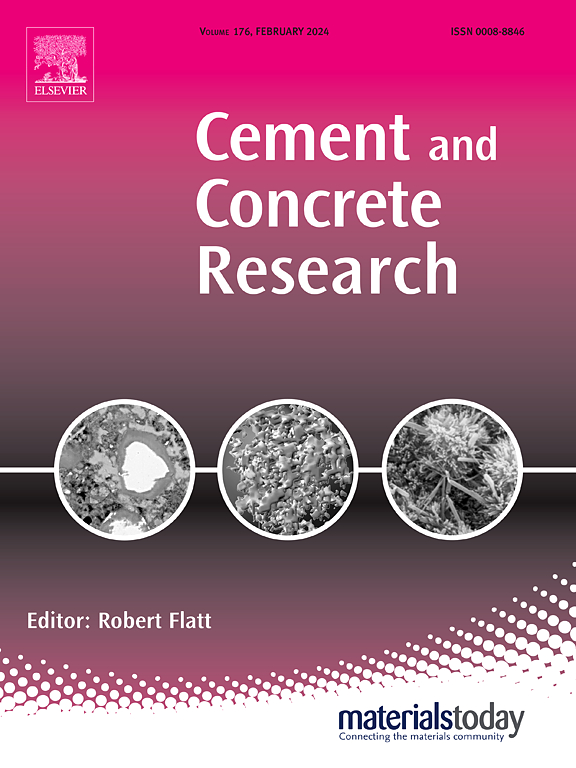探讨Na-Ye' limit和Ti-Ferrite固溶体的水化势和动力学
IF 13.1
1区 工程技术
Q1 CONSTRUCTION & BUILDING TECHNOLOGY
引用次数: 0
摘要
在原料混合物中加入铝土矿渣将Na+和Ti4+引入到硫铝酸钙熟料的结晶相中。为了模拟这样的体系,Na-Fe-ye'elimite (C₃.₉N₀.₁a₂.₈F₀.₂Ŝ)和Ti-ferrite (C₂F₀.₇₆a₀.₂₄T₀.₁)分别在1285°C 2 h和1320°C 3 h下合成。定量x射线衍射(QXRD)显示固溶体中含有少量的钙铝酸盐相,而电子背散射衍射-能谱(EBSD-EDS)可以区分出富na的正交晶型和富fe的立方晶型。等温量热分析表明,Na-Fe-ye极限相推动了早期的热演化,而较高的铁素体和石膏(M > 0)延长了诱导过程,减弱了主水化峰。在不含铁素体的混合物中,立方晶型溶解最快,但当铁素体超过33%时,其Fe3+的释放加速了正交晶型的溶解,这一点得到了孔溶分析的证实。28d后,钠铁铁铁铁氧体混合物在M(硫酸盐与铁铁的摩尔比)≥2时被完全消耗,而铁氧体则保持部分惰性,可能是由于Ca2+/SO₄2 -吸附在FeAl表面。建议将铁素体限制在≤33 wt%,以实现更致密的组织,从而获得更好的性能。本文章由计算机程序翻译,如有差异,请以英文原文为准。
Exploring the hydration potential and kinetics of Na-Ye'elimite and Ti-Ferrite solid solutions
The addition of Bauxite residue in the raw mix introduces Na+ and Ti4+ into the crystalline phases of calcium-sulfoaluminate (CSA) clinkers. To mimic such a system, Na-Fe-ye'elimite (C₃.₉N₀.₁A₂.₈F₀.₂Ŝ) and Ti-ferrite (C₂F₀.₇₆A₀.₂₄T₀.₁) were synthesized at 1285 °C, 2 h, and 1320 °C, 3 h, respectively. Quantitative X-ray diffraction (QXRD) revealed solid solutions with minor Ca-aluminates phases, whereas electron backscattered diffraction-energy dispersive spectroscopy (EBSD-EDS) could distinguish Na-rich orthorhombic and Fe-rich cubic ye'elimite polymorphs. Isothermal calorimetry showed the Na-Fe-ye'elimite phase drives early heat evolution, whereas higher ferrite and gypsum (M > 0) prolong induction and attenuate the main hydration peak. In ferrite-free mixes, the cubic-ye'elimite polymorph dissolves fastest, but when ferrite exceeds 33 wt%, its Fe3+ release accelerates orthorhombic-ye'elimite dissolution, as confirmed by pore-solution analysis. After 28d, Na-Fe-ye'elimite is fully consumed at M (sulfate to ye'elimite molar ratio) ≥ 2 for ye'elimite-ferrite mixes, while ferrite remains partly inert, possibly from Ca2+/SO₄2− adsorb onto its Fe![]() Al surface. Limiting ferrite to ≤33 wt% is recommended to achieve more densification of the microstructure for better performance.
Al surface. Limiting ferrite to ≤33 wt% is recommended to achieve more densification of the microstructure for better performance.
求助全文
通过发布文献求助,成功后即可免费获取论文全文。
去求助
来源期刊

Cement and Concrete Research
工程技术-材料科学:综合
CiteScore
20.90
自引率
12.30%
发文量
318
审稿时长
53 days
期刊介绍:
Cement and Concrete Research is dedicated to publishing top-notch research on the materials science and engineering of cement, cement composites, mortars, concrete, and related materials incorporating cement or other mineral binders. The journal prioritizes reporting significant findings in research on the properties and performance of cementitious materials. It also covers novel experimental techniques, the latest analytical and modeling methods, examination and diagnosis of actual cement and concrete structures, and the exploration of potential improvements in materials.
 求助内容:
求助内容: 应助结果提醒方式:
应助结果提醒方式:


